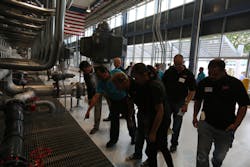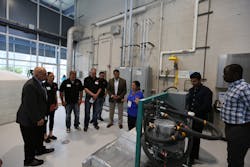The Kay Bailey Hutchison Desalination Plant has evolved into an industry model, attracting visitors from around the globe.
EL PASO, TEXAS, OCT 6, 2017 -- Employees, legislators and industry experts gathered Sept. 15 to celebrate the 10th anniversary of the Kay Bailey Hutchinson Desalination Plant. A centerpiece of the day was a research forum, featuring highlights of experimental work conducted at the in-house laboratory and how the findings could shape the future of desalination.
Celebrating sustainability
"Given the vast brackish groundwater resources, desalination has become an important part of the puzzle that will ensure we have a vital water future for this community, including for our kids, grandchildren and anybody that wants to live here in the future," said John Balliew, president and CEO of El Paso Water.
When Ed Archuleta first came to the utility in the late 1980s, El Paso was facing a bleak future in water management – including predictions the city would run out of water by 2009.
Archuleta, former president and CEO of the utility, spoke about the challenges El Paso faced when he first arrived.
"How can you have economic development if people don't have water," he said. "Water means public health, water means security, but it also means economic development. This city was trying to find ways to provide economic development, but we had this issue that we were known as the city that might run out of water."
Since opening in 2007, the groundbreaking KBH Desalination Plant has produced 17 billion gallons of water and played a pivotal role in building up El Paso's resiliency to droughts while meeting the water needs of a growing population. "The plant is a unique asset to this community that sets El Paso apart; it is a part of the story of the innovation here in El Paso," Mayor Dee Margo said.
"This stands as a great example to the rest of the arid west and is an essential component of El Paso's portfolio of water resources to help sustain the thriving local economy and the military operations at Fort Bliss," said Guy Carpenter, president of the national WateReuse Association.
The KBH Desalination Plant has also become a model, attracting visitors from around the globe, including from as far away as Brazil, Israel China, Iraq and Sudan. Many of these countries are also facing more frequent droughts and other serious water supply challenges.






